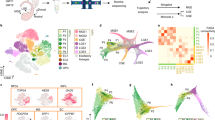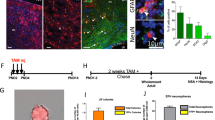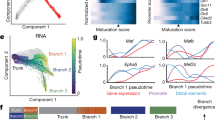Abstract
Throughout life, neural stem cells (NSCs) in different domains of the ventricular-subventricular zone (V-SVZ) of the adult rodent brain generate several subtypes of interneurons that regulate the function of the olfactory bulb. The full extent of diversity among adult NSCs and their progeny is not known. Here, we report the generation of at least four previously unknown olfactory bulb interneuron subtypes that are produced in finely patterned progenitor domains in the anterior ventral V-SVZ of both the neonatal and adult mouse brain. Progenitors of these interneurons are responsive to sonic hedgehog and are organized into microdomains that correlate with the expression domains of the Nkx6.2 and Zic family of transcription factors. This work reveals an unexpected degree of complexity in the specification and patterning of NSCs in the postnatal mouse brain.
This is a preview of subscription content, access via your institution
Access options
Subscribe to this journal
Receive 12 print issues and online access
$209.00 per year
only $17.42 per issue
Buy this article
- Purchase on Springer Link
- Instant access to full article PDF
Prices may be subject to local taxes which are calculated during checkout







Similar content being viewed by others
References
Alvarez-Buylla, A. & Garcia-Verdugo, J.M. Neurogenesis in adult subventricular zone. J. Neurosci. 22, 629–634 (2002).
Sakamoto, M. et al. Continuous neurogenesis in the adult forebrain is required for innate olfactory responses. Proc. Natl. Acad. Sci. USA 108, 8479–8484 (2011).
Imayoshi, I. et al. Roles of continuous neurogenesis in the structural and functional integrity of the adult forebrain. Nat. Neurosci. 11, 1153–1161 (2008).
Kosaka, K. et al. Chemically defined neuron groups and their subpopulations in the glomerular layer of the rat main olfactory bulb. Neurosci. Res. 23, 73–88 (1995).
Price, J.L. & Powell, T.P. The mitral and short axon cells of the olfactory bulb. J. Cell Sci. 7, 631–651 (1970).
Shepherd, G.M. The Synaptic Organization of the Brain (Oxford Univ. Press, 2004).
Doetsch, F., Caille, I., Lim, D.A., Garcia-Verdugo, J.M. & Alvarez-Buylla, A. Subventricular zone astrocytes are neural stem cells in the adult mammalian brain. Cell 97, 703–716 (1999).
Alvarez-Buylla, A., Kohwi, M., Nguyen, T.M. & Merkle, F.T. The heterogeneity of adult neural stem cells and the emerging complexity of their niche. Cold Spring Harb. Symp. Quant. Biol. 73, 357–365 (2008).
Merkle, F.T., Mirzadeh, Z. & Alvarez-Buylla, A. Mosaic organization of neural stem cells in the adult brain. Science 317, 381–384 (2007).
Kelsch, W., Mosley, C.P., Lin, C.-W. & Lois, C. Distinct mammalian precursors are committed to generate neurons with defined dendritic projection patterns. PLoS Biol. 5, e300 (2007).
Ventura, R.E. & Goldman, J.E. Dorsal radial glia generate olfactory bulb interneurons in the postnatal murine brain. J. Neurosci. 27, 4297–4302 (2007).
Young, K.M., Fogarty, M., Kessaris, N. & Richardson, W.D. Subventricular zone stem cells are heterogeneous with respect to their embryonic origins and neurogenic fates in the adult olfactory bulb. J. Neurosci. 27, 8286–8296 (2007).
Kriegstein, A. & Alvarez-Buylla, A. The glial nature of embryonic and adult neural stem cells. Annu. Rev. Neurosci. 32, 149–184 (2009).
Novak, A., Guo, C., Yang, W., Nagy, A. & Lobe, C.G. Z/EG, a double reporter mouse line that expresses enhanced green fluorescent protein upon Cre-mediated excision. Genesis 28, 147–155 (2000).
Seri, B. et al. Composition and organization of the SCZ: a large germinal layer containing neural stem cells in the adult mammalian brain. Cereb. Cortex 16 (suppl. 1), i103–i111 (2006).
Kohwi, M. et al. A subpopulation of olfactory bulb GABAergic interneurons is derived from Emx1- and Dlx5/6-expressing progenitors. J. Neurosci. 27, 6878–6891 (2007).
Alonso, M. et al. Turning astrocytes from the rostral migratory stream into neurons: a role for the olfactory sensory organ. J. Neurosci. 28, 11089–11102 (2008).
Mirzadeh, Z., Merkle, F.T., Soriano-Navarro, M., Garcia-Verdugo, J.M. & Alvarez-Buylla, A. Neural stem cells confer unique pinwheel architecture to the ventricular surface in neurogenic regions of the adult brain. Cell Stem Cell 3, 265–278 (2008).
Shepherd, G., Chen, W., Willhite, D., Migliore, M. & Greer, C. The olfactory granule cell: from classical enigma to central role in olfactory processing. Brain Res. Brain Res. Rev. 55, 373–382 (2007).
Schneider, S.P. & Macrides, F. Laminar distributions of interneurons in main olfactory-bulb of adult hamster. Brain Res. Bull. 3, 73–82 (1978).
Mori, K., Kishi, K. & Ojima, H. Distribution of dendrites of mitral, displaced mitral, tufted, and granule cells in the rabbit olfactory-bulb. J. Comp. Neurol. 219, 339–355 (1983).
Blanes, T. Sobre algunos puntos dudosos de la estrucutra del bulbo olfactario. Revista Trimestral Micrografica 3, 99–127 (1898).
Shepherd, G.M. Synaptic organization of the mammalian olfactory bulb. Physiol. Rev. 52, 864–917 (1972).
López-Mascaraque, L., De Carlos, J.A. & Valverde, F. Structure of the olfactory bulb of the hedgehog (Erinaceus europaeus): a Golgi study of the intrinsic organization of the superficial layers. J. Comp. Neurol. 301, 243–261 (1990).
Larriva-Sahd, J. The accessory olfactory bulb in the adult rat: a cytological study of its cell types, neuropil, neuronal modules, and interactions with the main olfactory system. J. Comp. Neurol. 510, 309–350 (2008).
Van Gehuchten, A.I.M. Le bulbe olfactif chez quelques mammiferes. Cellule 5, 205–237 (1891).
Ihrie, R.A. et al. Persistent sonic hedgehog signaling in adult brain determines neural stem cell positional identity. Neuron 71, 250–262 (2011).
Ahn, S. & Joyner, A.L. Dynamic changes in the response of cells to positive hedgehog signaling during mouse limb patterning. Cell 118, 505–516 (2004).
Danielian, P.S., Muccino, D., Rowitch, D.H., Michael, S.K. & McMahon, A.P. Modification of gene activity in mouse embryos in utero by a tamoxifen-inducible form of Cre recombinase. Curr. Biol. 8, 1323–1326 (1998).
Mao, J. et al. A novel somatic mouse model to survey tumorigenic potential applied to the Hedgehog pathway. Cancer Res. 66, 10171–10178 (2006).
Price, M. Members of the Dlx- and Nkx2-gene families are regionally expressed in the developing forebrain. J. Neurobiol. 24, 1385–1399 (1993).
Sussel, L., Marin, O., Kimura, S. & Rubenstein, J.L. Loss of Nkx2.1 homeobox gene function results in a ventral to dorsal molecular respecification within the basal telencephalon: evidence for a transformation of the pallidum into the striatum. Development 126, 3359–3370 (1999).
Marin, O., Anderson, S.A. & Rubenstein, J.L. Origin and molecular specification of striatal interneurons. J. Neurosci. 20, 6063–6076 (2000).
Flames, N. et al. Delineation of multiple subpallial progenitor domains by the combinatorial expression of transcriptional codes. J. Neurosci. 27, 9682–9695 (2007).
Taniguchi, H., Lu, J. & Huang, Z.J. The spatial and temporal origin of chandelier cells in mouse neocortex. Science 339, 70–74 (2013).
Magno, L., Catanzariti, V., Nitsch, R., Krude, H. & Naumann, T. Ongoing expression of Nkx2.1 in the postnatal mouse forebrain: potential for understanding NKX2.1 haploinsufficiency in humans? Brain Res. 1304, 164–186 (2009).
Xu, Q., Tam, M. & Anderson, S.A. Fate mapping Nkx2.1-lineage cells in the mouse telencephalon. J. Comp. Neurol. 506, 16–29 (2008).
Tsai, H.-H. et al. Regional astrocyte allocation regulates CNS synaptogenesis and repair. Science 10.1126/science.1222381 (2012).
Inan, M., Welagen, J. & Anderson, S.A. Spatial and temporal bias in the mitotic origins of somatostatin- and parvalbumin-expressing interneuron subgroups and the chandelier subtype in the medial ganglionic eminence. Cereb. Cortex 22, 820–827 (2012).
Moreno-Bravo, J.A., Perez-Balaguer, A., Martinez, S. & Puelles, E. Dynamic expression patterns of Nkx6.1 and Nkx6.2 in the developing mes-diencephalic basal plate. Dev. Dyn. 239, 2094–2101 (2010).
Inoue, T., Ota, M., Ogawa, M., Mikoshiba, K. & Aruga, J. Zic1 and Zic3 regulate medial forebrain development through expansion of neuronal progenitors. J. Neurosci. 27, 5461–5473 (2007).
Aruga, J. et al. A novel zinc finger protein, zic, is involved in neurogenesis, especially in the cell lineage of cerebellar granule cells. J. Neurochem. 63, 1880–1890 (1994).
Wataya, T. et al. Minimization of exogenous signals in ES cell culture induces rostral hypothalamic differentiation. Proc. Natl. Acad. Sci. USA 105, 11796–11801 (2008).
Borghesani, P.R. et al. BDNF stimulates migration of cerebellar granule cells. Development 129, 1435–1442 (2002).
Doetsch, F., Garcia-Verdugo, J.M. & Alvarez-Buylla, A. Cellular composition and three-dimensional organization of the subventricular germinal zone in the adult mammalian brain. J. Neurosci. 17, 5046–5061 (1997).
Puelles, L. et al. Pallial and subpallial derivatives in the embryonic chick and mouse telencephalon, traced by the expression of the genes Dlx-2, Emx-1, Nkx-2.1, Pax-6, and Tbr-1. J. Comp. Neurol. 424, 409–438 (2000).
Waclaw, R.R. et al. The zinc finger transcription factor sp8 regulates the generation and diversity of olfactory bulb interneurons. Neuron 49, 503–516 (2006).
Fogarty, M. et al. Spatial genetic patterning of the embryonic neuroepithelium generates GABAergic interneuron diversity in the adult cortex. J. Neurosci. 27, 10935–10946 (2007).
Lee, E.C. et al. A highly efficient Escherichia coli-based chromosome engineering system adapted for recombinogenic targeting and subcloning of BAC DNA. Genomics 73, 56–65 (2001).
Acknowledgements
We would like to thank T. Nguyen, Z. Mirzadeh and R. Ihrie for comments and discussions that improved this study, and D. Rowitch (University of California, San Francisco) and R. Segal (Harvard Medical School) for generously sharing antibodies. R. Romero provided outstanding technical assistance with histology. M. Grist, U. Dennehy and M. Humphreys generated the Nkx6.2∷CreERT2 transgenic mice, and Gli1∷CreERT2 mice were generously provided by A. Joyner (Sloan-Kettering Institute). F.T.M. was supported by the US National Science Foundation, the Jane Coffin Childs Memorial Fund, the US National Institutes of Health (NIH) and the Harvard Stem Cell Institute. L.C.F. was supported by the Howard Hughes Medical Institute and the Helen Hay Whitney Foundation. This study was supported by grants from the NIH (HD 32116 and NS 28478), the John G. Bowes Research Fund, the European Research Council (207807) and the UK Medical Research Council (86419).
Author information
Authors and Affiliations
Contributions
F.T.M., L.C.F. and A.A.-B. conceived and designed the experiments. F.T.M., L.C.F., T.A.S. and L.M. conducted experiments. N.K. developed the Nkx6.2CreERT2 transgenic mice and critically reviewed and edited the manuscript. F.T.M., L.C.F. and A.A.-B. analyzed data and prepared the manuscript. F.T.M. wrote the manuscript.
Corresponding author
Ethics declarations
Competing interests
The authors declare no competing financial interests.
Integrated supplementary information
Supplementary Figure 1 Type 1–4 cells have unique morphologies.
All cells are shown to scale and were traced using a camera lucida, digitized, and colored. Type 1 cells (red) resemble known granule cell types, but have cell bodies located in the superficial GRL and dendrites restricted to the deep layers of the EPL and below. Type 2 cells (blue) have cell bodies in the MCL and a spatially restricted, superficially directed, and highly branched dendritic arbor. Type 3 cells (magenta) have cell bodies in the MCL and relatively thin but highly branching processes concentrated in the IPL and MCL. Type 4 cells (green) are located in the EPL and have branched dendritic arbors with processes that tend to align vertically. Scale bar is 50 μm.
Supplementary Figure 2 Type 1–4 cells express markers of interneurons.
A subpopulation of Type 1-4 cells strongly expresses the calcium binding protein and interneuron marker calretinin (CalR). Type 1-4 cells were negative for parvalbumin (PV), though rare cells in the EPL are clearly immunopositive for PV (pictured). These cells were larger than Type 4 cells and likely respond instead to Van Gehuchten cells. Scale bar for all photomigrographs is 50 μm.
Supplementary Figure 3 Generation and characterization of Nkx6.2::CreERT2 mice
a,b) Strategy for the generation of mice expressing CreERT2 under control of Nkx6.2. Structure of the unmodified genomic BAC used for generation of the transgene (a) and modification of the genomic BAC containing the Nkx6.2 gene by insertion of iCreERT2-polyA within the first coding exon (b). c) RNA in situ hybridization showing expression of Nkx6.2 at E11.5 and E15.5. d) RNA in situ hybridization showing expression of the CreERT2 transgene at E11.5 and E15.5. The endogenous Nkx6.2 gene and the transgene are both expressed in the interganglionic sulcus at E11.5. At E15.5, the transcripts can still be detected in the sulcus but strong expression can also be observed in the V-SVZ.
Supplementary Figure 4 Zic-immunopositive OB interneurons are generated in a medial and anterior domain.
Neurolucida traces of coronal sections from Z/EG mice brains injected at P0 with Ad:Cre to target radial glia on the medial wall of the anterior ventral V-SVZ. The surface of the brain is colored in gray, the lateral ventricle is shown in light purple, and the domain containing Zic immunopositive cells is shown in light red. Radial glial-derived (GFP+) V-SVZ cells are indicated in bright green. Injections were then classified into two groups (a and b) based on the ratio of periglomerular to granule cells in the OB (PGC/GC). As previously described, high ratios (>2) correlated with the presence of more rostrally located GFP+ cells in the V-SVZ. a) The more posterior labeling group had low PGC/GC ratios and intermediate percentages of Zic immunoreactivity among PGCs. Labeling in the V-SVZ was concentrated near the ventral tip of the lateral ventricle. b) The more anterior labeling group was characterized by high PGC/GC ratios and a high percentage (>90%) of PGCs that expressed Zic. Furthermore, the vast majority of Type 1 and Type 3 cells derived from this domain were Zic+.
Supplementary Figure 5 Zic is expressed in a subset of CalR+ PGCs.
Double immunostaining for Zic and markers of PGC subtypes demonstrates co-labeling among Zic and CalR, but very little overlap with CalB or TH. This result is consistent with the previously identified medial anterior domain of CalR+ PGC generation. The presence of a Zic-/CalR+ population is consistent with the observed origin of CalR+ PGCs from other regions such as the cortical V-SVZ, whereas the presence of Zic+/CalR- cells suggests the presence of additional interneuron subtypes among the Zic+ population.
Supplementary Figure 6 The location and morphology of type 1–4 cells suggests unique key roles in OB function.
Here we speculate as to what roles Type 1-4 cells might play in the OB circuitry, bearing in mind that these hypotheses must be tested in future experiments. Type 1 cells (red) may receive axonal (possibly dendritic) input within the superficial granule cell layer and internal plexiform layer and inhibit the cell bodies and proximal dendrites of mitral (black) and tufted cells above them, thereby mediating columnar inhibition. The highly branched, spatially restricted arbors of Type 2 cells (blue) are positioned to inhibit the cell bodies and proximal dendrites of neighboring mitral and deep tufted cells and could mediate localized lateral inhibition. The varicosities and spines of Type 3 (magenta) and 4 cells (green) may be sites of unidirectional (pre or post-synaptic only) or reciprocal synapses. If they are post-synaptic, Type 3 and 4 cells may detect the output of mitral and tufted cells or local processing in their dendrites and relay this activity to other cells in the column via their radially projecting axons. If they have reciprocal synapses or pre-synaptic structures, Type 3 and 4 cells may inhibit the output of mitral and tufted cells or inhibit their dendrites, respectively.
Supplementary information
Supplementary Text and Figures
Supplementary Figures 1–6 and Supplementary Table 1 (PDF 4548 kb)
Source data
Rights and permissions
About this article
Cite this article
Merkle, F., Fuentealba, L., Sanders, T. et al. Adult neural stem cells in distinct microdomains generate previously unknown interneuron types. Nat Neurosci 17, 207–214 (2014). https://doi.org/10.1038/nn.3610
Received:
Accepted:
Published:
Issue Date:
DOI: https://doi.org/10.1038/nn.3610
This article is cited by
-
Neurogenesis of medium spiny neurons in the nucleus accumbens continues into adulthood and is enhanced by pathological pain
Molecular Psychiatry (2021)
-
Distribution and classification of the extracellular matrix in the olfactory bulb
Brain Structure and Function (2020)
-
Gender-specific effects of transthyretin on neural stem cell fate in the subventricular zone of the adult mouse
Scientific Reports (2019)
-
Same path, different beginnings
Nature Neuroscience (2018)
-
Diverse populations of local interneurons integrate into the Drosophila adult olfactory circuit
Nature Communications (2018)



